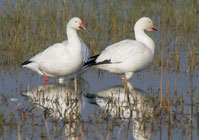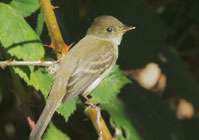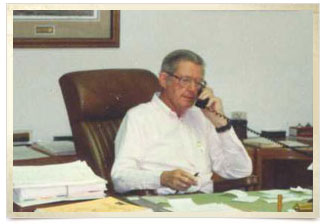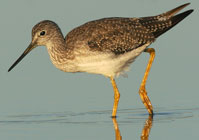Accomplishments
The CVJV partnership has earned an impressive record of accomplishment since its inception in 1988, and is making great progress towards meeting the objectives identified in its 2020 Implementation Plan.

 Willow Flycatcher
Willow Flycatcher Dan Chapin
Dan Chapin
The Central Valley Joint Venture and the Pacific Flyway waterfowl community lost one of their greatest champions this spring with the passing of Dan Chapin. Dan was a leader, mentor, advocate, and visionary without peer in the history of wetlands conservation in California. He will long be remembered by those whose lives and passion are dedicated to the protection and restoration of Central Valley waterfowl and their habitats.
Dan Chapin was born November 14, 1926 in Gross Point, Michigan. His father, Roy Chapin, was founder of the Hudson Motor Car Company and also served as Secretary of Transportation under President Herbert Hoover. Dan grew up in Michigan, and attended Yale University where he attained a degree in engineering. After a long and successful business career, he decided to dedicate himself full time to conservation and became Vice President of Government Affairs for the California Waterfowl Association. A modest man, Dan worked tirelessly throughout the western US for the next 20 years to protect the birds and wildlife he loved.
All agree that Dan was an indispensable player in the Central Valley Habitat Joint Venture from the very beginning. Former Joint Venture Coordinator Dave Paullin remembers his early influence fondly. "In l988-89 the Central Valley Habitat Joint Venture (now known as the Central Valley Joint Venture) was just getting off the ground. The big task was to write an implementation plan, form a management board, come to some understanding about how a Joint Venture would operate and then jump in and tackle our objectives vigorously. When I showed up in the spring of l989 to be the first "official" JV coordinator, Dan Chapin was by far the hub of the wheel. He was at the center of everything and was our first Management Board Chairman – the second one too, serving back-to-back terms to get us off on the right foot. I relied on Dan heavily as we muddled through how to make a Joint Venture work.”
While he had many achievements over his long and distinguished career, perhaps his greatest contribution was in the area of water. Dan worked tirelessly, and skillfully, behind the scenes in Sacramento, and in Washington DC, to ensure that private duck clubs and the public waterfowl areas got water for their wetlands. The apex of those efforts was his work on the "Mitchell Bill" which ultimately became the Central Valley Project Improvement Act – CVPIA. Dan Chapin deserves most of the credit for the language in CVPIA that carved out firm water supplies for federal refuges, state wildlife areas, and private wetlands within the Grassland Resource Conservation District. Grasslands General Manager Dave Widell concurs, "I think of Dan each year when we begin to flood the Grasslands, for if not for him and his ability to get refuge water supplies into CVPIA, many of us may well be in other professions and would not have been given the water resources to make the incredible gains we have since Dan's work back in the early 90's.”
By word and deed, Dan was a man that inspired respect and affection. A story from Dave Paullin demonstrates why. "I clearly remember the very first day I met Dan. It was about l979-80. I was a junior-pup biologist working for the U.S. Fish and Wildlife Service out of Portland, Oregon. My job was to go down to California and sell all the key stakeholders in the waterfowl community on the idea of protecting the Napa-Petaluma marshes west of Vallejo as a new National Wildlife Refuge – no small task. At the time, the Service and the California Department of Fish and Game were not seeing eye to eye over a controversial issue – steel shot. Through the grapevine I had heard many stories about how ugly things had become and in particular there was one passionate, firebrand who was widely known for this vocal criticism of Service policy in general and "feds" in particular – Dan Chapin.
I had heard about this fellow for years by reputation, and local folklore within the Service had made him sound like something bigger than life. I was now about to meet this great fed-bashing ogre of legendary proportions. As a young biologist from the boonies of eastern Oregon who was totally green to the ways of California, I felt like Bert Larr (the cowardly lion) meeting the Great Oz. I was totally intimidated. I did my presentation and things went very well. Dan was polite, attentive, and asked several good questions. I was pleased with myself and was thinking that things had gone pretty well until he asked me for my business card. I didn't have one. Incredulous, he gave me a look that could burn holes through steel followed by a lecture in a stern yet professional tone why I should always have a business card. I had just been handed my head on a platter. I was devastated. After our first encounter the score was Oz 1, Lion zero. I never forgot that lesson and I was never without a business card following that humbling encounter.
About 10 years later, I moved to Sacramento and worked with Dan very closely for 9 years through the Central Valley Habitat Joint Venture. I quickly learned that he was not an ogre at all but a true gentleman in every sense of the word who did not suffer fools kindly. If you knew your stuff, worked hard, and were passionate about waterfowl, wetlands, and hunting you had his respect. We became good friends over those years and the memories are good. Those were some of the best years of my career.”
Red Hunt, former Chief of the Department of Fish and Game's Wildlife Management Division, believes that Dan's ability to influence others was his greatest gift. He has good reason to think so. To learn why, read his story. It demonstrates how Dan could be so effective, and why he was such an indispensable part of the CVJV.
Dan Chapin was a mentor, friend and inspiration to countless individual's who shared his passion for wetlands and waterfowl. Their memories of him, along with his profound and enduring influence on the landscape of California, will stand forever as a testament to a man committed to leaving the world a better place than when he found it.
The CVJV partnership has earned an impressive record of accomplishment since its inception in 1988, and is making great progress towards meeting the objectives identified in its 2020 Implementation Plan.

Follow these links to learn about some of the important bird conservation work happening in California's Central Valley.
